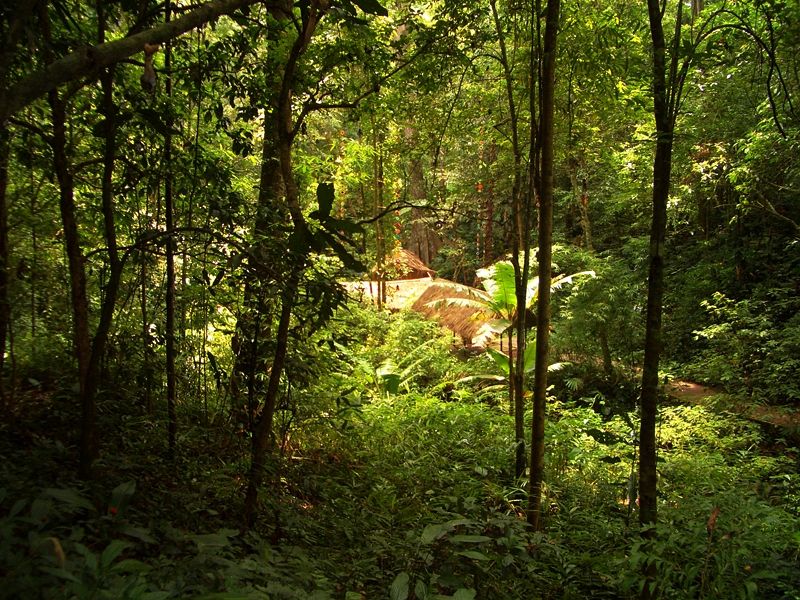(单词翻译:单击)
中英文本
China has more plants than anywhere else in the temperate regions of the world. In fact, it has almost twice as many kinds of plants as there are in the United States which is about the same size and about three times as many as there are in Europe. It's a very wonderful wealth of plant species, many of which have contributed to our gardens, like rhododendrons, and azaleas, and forsythias, to our cultivated plants like soybeans.
中国拥有的植物种类比世界上其他任何温带地区的国家都多。事实上,中国的植物种类是和他面积差不多大的美国的两倍,是欧洲的三倍。植物种类是非常丰富多彩的财富,它们装点了我们的花园,像杜鹃,连翘,给我们提供了种植作物,像大豆。
The reason that there're so many plants in China is that they've survived there better. If you go back fifteen million years into the past, you find much the same kinds of plants and the animals in the United States, Europe and China. They've survived in the warm temperate to subtropical forests that stretch right across the middle of China.
中国植物物种如此丰富的原因是植物在那里可以更好的生长。如果时光倒转1500万年,你可以在美国,欧洲和中国发现很多相同种类的植物和动物。他们生长在中国跨越暖温带和亚热带的森林里。
In those forests of China we have surviving species like gingko, the maidenhair tree which has been in cultivation in Europe and North America since the 17th century. A wonderful relic in those forests is the dove tree, Davidia. It's called the dove tree because the fluttering bracts that hang down from the clusters of flowers look like doves flying.
在中国的森林里我们可以找到银杏和孔雀草,它们从17世纪开始就在欧洲和北美被种植。在那些森林里很神奇的一个遗迹就是名叫Davidia的鸽子树。它被称为鸽子树是因为花簇上面摆动的花苞就像展翅欲飞的鸽子一样。
Another example is the dawn red wood, metasequoia, which was described as a fossil in 1941. Forty million years ago, it was the commonest forest tree in Western North America, now it's completely wiped out there, but it survives as about 6,000 individuals in China.
另外一个例子是黎明红木,水杉,在1941年的时候被称为活化石。4000万年前,水杉是北美西部最常见的树种,现在几乎已经灭绝了,但是在中国却又6千株。
The western half of China in the interior of Asia consists of very tough deserts. In the harsh landscape of Tibet there exist a whole series of herbs, sedges, grasses, saussurea, primroses that are found only there. Some groups of plants, like sorseria for example, have their buds protected against the low temperatures, they keep on growing.
中国的西部在亚洲的内部,有着条件非常恶劣的沙漠。在西藏的原野上,生长着一系列的药草,菅茅,雪莲,樱草,而这些植物只有在西藏才有。有一些植株,像sorseria,它们发芽来抵御低温,一直都保持生长。

Another reason that there're so many kinds of plants in China is that unlike the United States or Europe, there's real tropical forest in the south tropical rain forests in southern Yunnan, and in that tropical forest, there are many species that come up from the south. They give the province of Yunnan about as many species, one state of China, and in fact about as many species as there are in the United States and Canada combined, about 15,000 kinds of plants. And it's the melding of all of those regions, the survival of species from the past and the creation of many new species by the forces in evolution and the diverse topography of China that's produced so much variety, so wonderfully pleasing and exciting to see.
中国物种多的另一个原因是,和美国和欧洲不同,在南部的云南,中国有着真正的热带雨林。在那片热带雨林里,有非常非常多从南方来的物种。它给予中国这个南部的省份,云南,相当于美国和加拿大所有的物种,大约1.5万种,是其他所有地区的总和。从过去存活下来的物种,在进化过程中新产生的物种和中国多种多样的地质特征共同催生了这么多的物种,令人应接不暇。
China is doing the best that it can to save its biological diversity including its floral heritage. Chinese officials are very concerned with this, but it's very difficult to meet the needs of 1.3 billion people to allow them to consume more, to give them things that they want like automobiles and other imports from the west and still to preserve the natural landscape or even the quality of the air, the water. They're fighting that battle, a battle with which we are all familiar well, but they're going to have to do a great deal more in the future as we all are.
中国尽最大努力来保持生物的多样性,包括它的植物遗产。中国政府对此非常关注。但是要满足13亿人的消费需求给他们所需要的机动车,从西方进口产品来保护自然环境和空气,水的质量仍然是非常困难的事情。他们在进行一场保护环境的战争,一场我们非常熟悉的战争。但是在将来,他们需要做的更多。
重点讲解
1.as many as 和……一样多;不下于
As many as ten-million children will have been infected with the virus by the end of the decade.
到这个十年结束时,多达千万的儿童将会感染上这种病毒。
2.wipe out 摧毁;毁灭;使灭绝
The spill could wipe out the Gulf's turtle population.
这次原油泄漏可能会使波斯湾的海龟灭绝。
3.consist of... 包括;由……组成
The division will consist of two tank companies and one infantry company.
这个师的组成部队将包括两个坦克连和一个步兵连。


